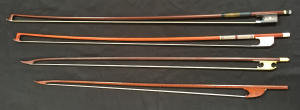I own three historic-style bows, all of which are modern reproductions made in the 20th to 21st centuries. Each bow is designed for playing repertoire from a specific historical era as follows:
Short bow– designed for performing repertoire from ca. 1600-1700 (weight = approximately 44 grams)
High-baroque bow– designed for playing repertoire from ca. 1700-1800 (weight = approximately 50 grams)
Classical bow– designed for performing repertoire from ca. 1750-1900 (weight = approximately 52 grams[1]
Consequently, each bow has specific qualities making it more or less successful for executing certain approaches discussed in this research. For instance, my short bow has excellent articulation, making it the perfect tool for col legno battuto, ricochet or jeté. My high-baroque bow has a fluted stick, which makes a wonderful col legno tratto sound. My classical bow has the hammer-shaped point typical of a modern bow, making it ideal for more sustained passage-work and Japsends in the upper half of the bow.
Figure 2 – from top to bottom, modern bow by unknown maker (ca. 2005), “Father Tourte model” classical bow by Solange Chivas (2013), high-baroque bow by Daniel Latour (ca. 1970), “1650 model” short-bow by Solange Chivas (2015)
___________________________________________________________________________________________________[1] For comparison, the average modern violin bow is approximately 60 grams in weight.
